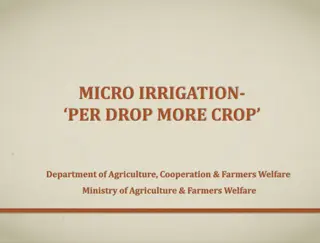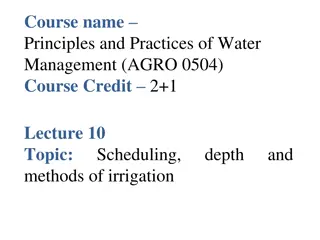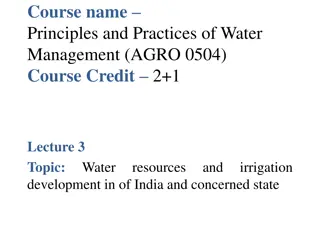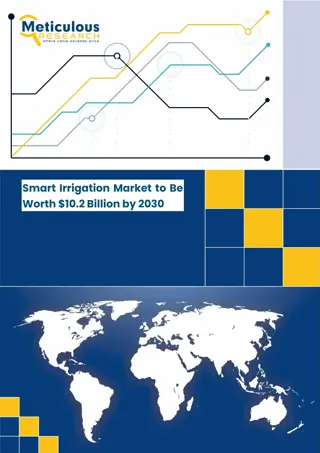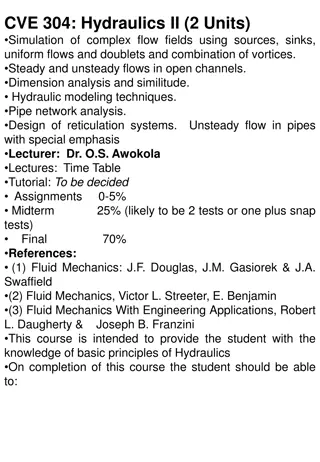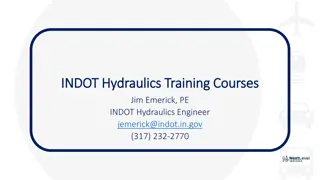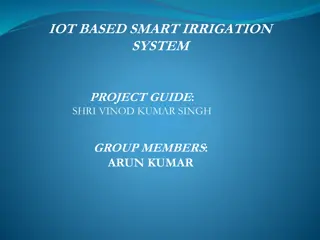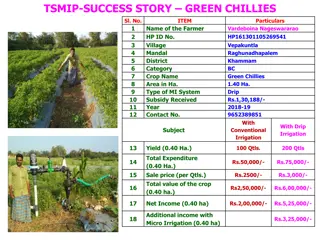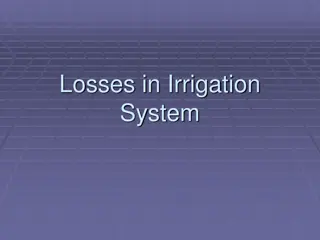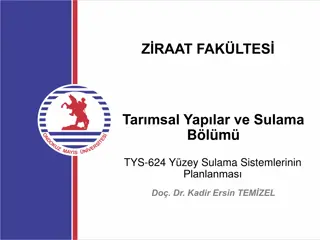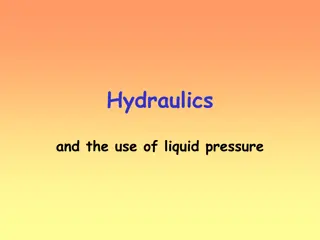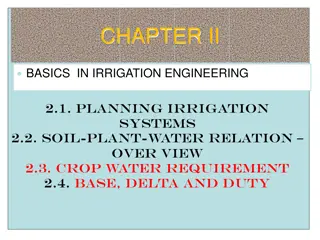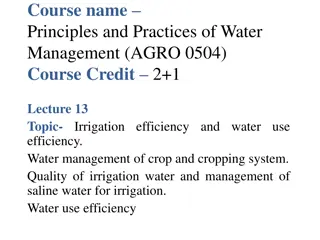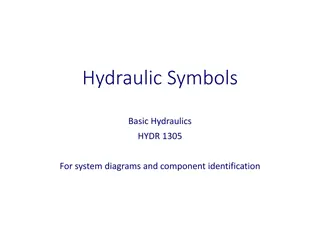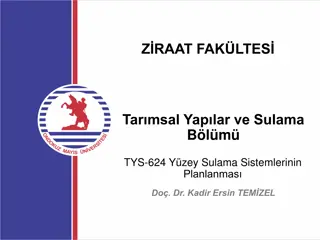Understanding Basic Hydraulics in Irrigation Systems
Hydraulics is crucial in designing efficient irrigation systems. This branch of science involves the study of water or liquids in motion, focusing on flow, velocity, pressure relationships, and pressure losses in pipes. Learn how to make cost-effective design decisions and ensure uniform water distribution for easier installation and maintenance.
Download Presentation

Please find below an Image/Link to download the presentation.
The content on the website is provided AS IS for your information and personal use only. It may not be sold, licensed, or shared on other websites without obtaining consent from the author. Download presentation by click this link. If you encounter any issues during the download, it is possible that the publisher has removed the file from their server.
E N D
Presentation Transcript
ZRAAT FAKLTES Tar msal Yap lar ve Sulama B l m TYS-624 Y zey Sulama Sistemlerinin Planlanmas Do . Dr. Kadir Ersin TEM ZEL
Yzey sularnn lmnde kullan lan aletler TYS-624 Y zey Sulama Sistemlerinin Planlanmas Hafta-7
Basic Hydraulics Irrigation
Objectives: 1) Explain basic hydraulics 2) Describe the relationships between flow, velocity, and pressure 3) Determine pressure losses in pipe and fittings and pressures at various points in irrigation systems 4) Describe how to make efficient and economical irrigation design decisions 5) Explain how more uniform distribution of water cost less to install and maintain
Reasons to Learn 1) Why is it important to be able to understand basic hydraulics? 2) Why is it important to identify the relationships between flow, velocity and pressure? 3) Why is it important to determine pressure losses in pipe and fittings and pressures at various points in irrigation systems? 4) Why is it necessary to be able to make efficient and economical irrigation design decisions? 5) Why is it important to be able to explain how more uniform distribution of water cost less to install and maintain?
Questions to Answer 1) What do we need to know in order to be able to understand basic hydraulics? 2) What do we need to know to identify the relationships between flow, velocity and pressure? 3) What do we need to know to determine pressure losses in pipe and fittings and pressures at various points in irrigation systems? 4) What do we need to know to be able to make efficient and economical irrigation design decisions? 5) What do we need to know to be able to explain how more uniform distribution of water cost less to install and maintain?
Introduction Hydraulics is defined as a branch of science that deals with the effects of water or other liquids in motion. Characteristics of water- in motion and at rest Relationships between flow, velocity, and pressure Pressure losses in pipe fittings Pressures at various points in an irrigation system
Introduction Basic knowledge provides: Ability to design and maintain economical and efficient irrigation systems Systems that have a more uniform distribution of water Cost less to install and maintain
Effects of Hydraulics Water pressure affects sprinkler performance Correct design will allow all sprinklers to operate correctly Incorrect design will result in poor water distribution and a lack of uniform coverage Consistent pressure is the primary goal of the design This must be obtained at the lowest possible cost Designing a system that uses the smallest and least amount of components is critical to keep costs down. The system must however be able to conserve sufficient pressure to ensure optimal performance.
Water Pressure Water pressure is created in two ways: Using the weight of water (water tower) The use of a pump (mechanical pressurization)
Water Pressure Municipalities use both methods for the water we receive at home and business Water tanks use gravity to produce pressure Tanks are usually located on hill sides or built onto towers The weight of the water and the force of gravity give the water it s pressure booster pumps can also be used to increase pressure where home may be higher than the tanks Pumps are also used in ground and surface water retrieval
Water Pressure Water pressure can be measured in several ways: Psi or pounds per square inch this is the most common expression Feet oh head pressure or the equivalence of pressure at the bottom of a column of water 1 ft. high (ft./hd.)
Water Pressure Water creates pressure in landscape irrigation systems by the accumulated weight of water. The weight of a 12in. high column of water weighs 0.433 lbs. (12in. x 0.00361 lbs. per in. = 0.433lbs.) This relationship shows as our column gets higher every 1 ft. of height added will increase pressure at the bottom by 0.433 psi.
Water Pressure Important Facts: 1 ft. column of water = 1 ft. of head pressure = 0.433 psi 1.0 psi equals the pressure created by a column of water 2.31 ft. high, or 1 psi = 2.31 ft. of head pressure (ft./hd.) 1 ft. column of water 1 ft. high creates 0.433 psi at the bottom, or 1 ft./hd. = 0.433 psi.
Shape or Size The shape or size of a container does not make any difference in the pressure at the bottom Pressure at an equal depth will be the same no matter what the size or shape of the container ( like diving into a pool vs. diving into a lake the pressure is the same as you descend) All pressure is dependent upon the depth of the water
Static and Dynamic Pressure There are two classifications of water pressure: Static Pressure- is a measurement of water pressure when water is at rest. Dynamic Pressure- (working pressure) measurement of water in motion
Static Pressure Factors that affect static pressure: Elevation change Each ft. of elevation change results in 0.433 psi change in pressure Static pressure is not affected by length of pipe only by elevation change.
Static Pressure Down hill Static pressure is 60 psi control valve below the meter by 8ft. static pressure will be increased by 3.46 psi. (8ft. x 0.433 psi per foot = 3.46 psi) so 3.46 + 60 = 63.46 psi static pressure.
Static Pressure Up hill For every 1 ft. of vertical elevation gain static pressure will drop by 0.433 psi. Assume same beginning static pressure of 60 psi and a 40 ft. elevation increase. 40ft. x 0.433 psi/ft. = 17.32 psi so 60 17.32 = 42.68 psi
Dynamic pressure Velocity- the speed at which water is moving, measured in feet per second (fps) Flow- the amount of water moving through the system, measured in gallons per minute (gpm) Dynamic water pressure like Static pressure is measured in psi
Dynamic pressure Factors that affect dynamic pressure: Change in elevation Friction losses in pipe, fittings and valves (caused b water moving through system) Velocity head pressure (pressure required to make water move within the system, this is a minor loss) Entrance losses ( pressure lost as water flows through openings; also a minor loss)
Friction loss in pipe After static pressure is determined we then subtract the pressure losses due to the movement of water Friction losses- refers to water moving through the system, the pressure lost by turbulence in pipes, valves, and fittings
Friction loss in pipe 4 factors: Velocity of water Inside diameter of the pipe The roughness of the inside of the pipe The length of the pipe
Friction loss in pipe Increasing velocity will cause increased turbulence and increased pressure losses With the increase in velocity (fps) there is a corresponding increase in flow (gpm) Velocity and flow are directly related an increase or decrease in one will result in the same of the other When velocity increases, pressure loss increases
Friction loss in pipe Velocity typically increases when: The flow is increased such as when sprinklers are added to an existing line A smaller pipe is used with the same flow (gpm)
Inside Diameter (i.d.) Smaller i.d. proportionally increases the amount of water in contact with the pipe surface. This contact increases turbulence thus increasing dynamic pressure loss Even with a smaller flow and the same velocity more turbulence is created in smaller pipes because there is a greater percentage of water in contact with pipe surface
Roughness The inside wall of the pipe affects friction loss in pipe Roughness is rated by a C factor The lower the C the rougher the pipe (steel pipe C = 100, pvc C = 150) The rougher the inside, the more turbulence and greater friction loss
Length The greater the distance, the greater the cumulative effect on the preceding factors of velocity, i.d., and roughness There is a direct relationship between length and increased pressure loss The total pressure loss doubles as the length of the pipe doubles
Length Several formulas for calculating pressure loss have been established: The most common is the Hazen-Williams formula: Hf = 0.090194 (100 / C) 1.852 x (Q 1.852 / d 4.866) Where: Hf = pressure loss in pounds per square inch (psi) C = roughness factor Q = flow in gallons per minute (gpm) d = inside diameter of pipe in inches These formulas are good to know however charts are available for ease of calculation
Charts Determine pressure loss in pipe due to friction loss Determine the velocity at various flow rates Use pressure losses and/or velocities to determine pipe size
Charts Using the chart: Find the flow of water in gpm on the left column Scan across the top to locate pipe size Read down this column, under the psi loss heading, and across the row for the gpm Multiply this number by 100 to find the psi per foot Multiply this number by the length of pipe ft. Ex. Find friction loss in 42ft. of in. class 200 pvc flowing 6 gpm 1.67 / 100 = .0167 psi pressure loss 0.0167 x 42 ft. = 0.701
Summary Water pressure is created by? Water pressure can be measured in? For every one foot of elevation change the water pressure does what?





